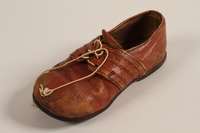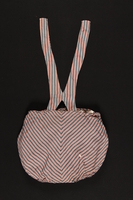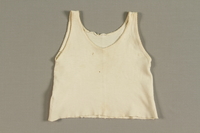Overview
- Brief Narrative
- Striped, Moroccan wool blanket used by Raya Markon, during her escape from Paris to the south of France in June 1940, on what became known as "L'exode" (Exodus). Raya used the blanket to cover the broken and exposed springs in the car seat while she traveled. Raya and Alexander were immigrants from Vilna, Poland, who had married in Paris in 1937. When Germany invaded France in May 1940, Raya fled Paris for Toulouse. She was joined by Alexander after his discharge from the French Army following the June surrender of France. The couple applied for US visas and, while they were waiting to receive them, Alain was born on June 23, 1941. They received their visas in 1942, and left for Lisbon, Portugal. They sailed from Lisbon in October 1942, and arrived in America in November.
- Date
-
use:
1940 June
emigration: 1942 October
- Geography
-
use:
France
- Credit Line
- United States Holocaust Memorial Museum Collection, Gift of Genya Markon, In Memory of Alain Markon and of our father Alexander Markon and in Honor of our mother Raya Magid Markon
- Contributor
-
Subject:
Raya M. Markon
- Biography
-
Raya Magid (1910-2005) was born to Abram and Genya Settel Magid in Vilna (now Vilnius), Lithuania. Her father graduated from a teacher’s college, and ran his own insurance business. Raya had an older sister, Katia (1905-1965). Raya first attended Hebrew school, then a Russian school for three years, followed by a French lycee for six years, until graduating from a Polish high school. She attended a Polish university where she studied romance languages, and studied for a year in Toulouse, France. Her parents requested her return around 1932, and she took a position with the Association of Lumber Exporters. In 1936, Raya became reacquainted with Alexander (Oswiez/Sasha, 1905-1989) Markon, who was also from Vilna, though he lived in France and was a French citizen. She had attended school with his sister and they began a courtship while he was visiting his family. When Alexander returned to France, he and Raya continued the courtship by mail. The two were married in France on February 11, 1937, and settled in Paris. Alexander worked as a translator at a publishing company, Dunod, while Raya worked as a secretary.
On September 1,1939, Germany invaded Poland. Alexander was recalled to the French military, and on September 4, 1939, was drafted to the center of mobilization at Orleans, Loiret. He was sent to the 55th Regiment of the artillery and stationed on the Maginot Line, a series of fortifications along the French-German border. Germany invaded France in May 1940, and in June, France surrendered. Alexander was demobilized and went south in the hopes of finding Raya, who had fled to Toulouse during the exodus from Paris ( L’Exode). He eventually found her by accident in a train station. Later, they found refuge in Leguevin in Haute Garonne.
Alexander worked as a farm laborer, and later in a shoe factory. The couple’s first child, Alain (1941-1998), was born in Toulouse in June 1941. The Markon family wished to immigrate to the United States, and applied for immigration visas. Raya’s first cousin, Lillian Epstein, lived in the US, and was married to a psychiatrist, Joseph Epstein. Joseph had connections in the US State Department and pleaded their case, eventually helping them to obtain an affidavit to enter the US in 1941. Despite this, they did not receive visas until 1942. With the sponsorship of the American Jewish Joint, the Markon family obtained passage to America aboard a Portuguese ship, the SS Carvalho Araujo. They sailed from Lisbon, Portugal, on October 20, 1942, and arrived in Baltimore, MD, on November 2. From there, they took a train to New York City. They were still there when their daughter, Genya (b.1943), was born two months later.
Raya’s mother, Genya, died of natural causes in the spring of 1941. Abram, Raya’s father, was executed that summer by German forces in Ponary, just outside Vilna. Raya’s sister, Katia Magid (1905-1965), was confined in the Vilna ghetto following the German invasion of the Soviet Union in June 1941. Katia survived being imprisoned in both Kaiserwald and Stutthof concentration camps, and immigrated to the US in 1947. She found work at the American Museum of Natural History using her language skills. Alexander held many different positions in the food industry, eventually becoming a food chemist for Dr. Brown’s Soda Company (American Beverages).
Physical Details
- Classification
-
Furnishings and Furniture
- Category
-
Household linens
- Object Type
-
Blankets (lcsh)
- Physical Description
- Large, rectangular woven wool blanket with multicolored horizontal stripes, edges finished in red, and scalloped long ends. The alternating pattern begins with a white stripe with a geometric design in brown, orange, green, red, blue, and dark red. Next are stripes of varying widths in dark red, green, orange, blue, white, dark brown and black. To the left and right of center is a green, blue, and orange woven stripe. The central stripe is dark brown with a blue and white diamond at the top, red and green squares in the center, and a dark red and blue diamond within a white rectangle at the bottom. The design repeats on both sides of center. A white paper label is stapled to one end.
- Dimensions
- overall: Height: 94.500 inches (240.03 cm) | Width: 60.000 inches (152.4 cm)
- Materials
- overall : wool, dye, paper
Rights & Restrictions
- Conditions on Access
- No restrictions on access
- Conditions on Use
- No restrictions on use
Keywords & Subjects
Administrative Notes
- Legal Status
- Permanent Collection
- Provenance
- The blanket was donated to the United States Holocaust Memorial Museum in 1998 by Genya Markon, the daughter of Raya Magid Markon.
- Funding Note
- The cataloging of this artifact has been supported by a grant from the Conference on Jewish Material Claims Against Germany.
- Record last modified:
- 2022-12-16 13:11:27
- This page:
- https://collections.ushmm.org/search/catalog/irn516460
Download & Licensing
In-Person Research
- By Appointment
- Request 21 Days in Advance of Visit
- Plan a Research Visit
- Request to See This Object
Contact Us
Also in Alain Markon and Raya Magid Markon family collection
The collection consists of a blanket and children's clothing relating to the experiences of Alexander and Raya Magid Markon and their young son, Alain, during the Holocaust when they escaped German occupied France for the United States.
Date: 1942

Toddler's red leather shoe worn by Alain Markon in Vichy France
Object
Red leather shoe worn by toddler Alain Markon while living under the Vichy regime in France with his parents, Alexander and Raya, in 1941 and 1942. Alain's parents were immigrants from Vilna, Poland (now Vilnius, Lithuania), who had married in Paris in 1937. When Germany invaded France in May 1940, his mother fled Paris for Toulouse. She was joined by his father after his discharge from the French Army following the June surrender of France. The couple applied for US visas. and, while they were waiting to receive them, Alain was born in June 1941. They received their visas in 1942, and made their way to Portugal. They sailed from Lisbon in October 1942, and arrived in the United States in November.

Toddler's red and blue striped rompers worn by Alain Markon in Vichy France
Object
Red and blue striped rompers worn by toddler Alain Markon while living under the Vichy regime in France with his parents, Alexander and Raya, in 1941 and 1942. Alain's parents were immigrants from Vilna, Poland (now Vilnius, Lithuania), who had married in Paris in 1937. When Germany invaded France in May 1940, his mother fled Paris for Toulouse. She was joined by his father after his discharge from the French Army following the June surrender of France. The couple applied for US visas. and, while they were waiting to receive them, Alain was born in June 1941. They received their visas in 1942, and made their way to Portugal. They sailed from Lisbon in October 1942, and arrived in the United States in November.

Toddler's white knit undershirt worn by Alain Markon in Vichy France
Object
White, knit, sleeveless undershirt worn by toddler Alain Markon while living under the Vichy regime in France with his parents, Alexander and Raya, in 1941 and 1942. Alain's parents were immigrants from Vilna, Poland (now Vilnius, Lithuania), who had married in Paris in 1937. When Germany invaded France in May 1940, his mother fled Paris for Toulouse. She was joined by his father after his discharge from the French Army following the June surrender of France. The couple applied for US visas. and, while they were waiting to receive them, Alain was born in June 1941. They received their visas in 1942, and made their way to Portugal. They sailed from Lisbon in October 1942, and arrived in the United States in November.



